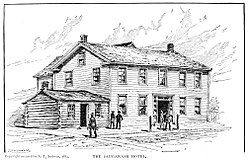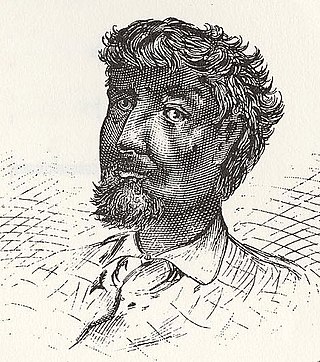
Jean Baptiste Point du Sable is regarded as the first permanent non-native settler of what would later become Chicago, Illinois. He is recognized as the city's founder. The site where he settled near the mouth of the Chicago River around the 1780s is memorialized as a National Historic Landmark, now located in Pioneer Court.

Fort Dearborn was a United States fort, first built in 1803 beside the Chicago River, in what is now Chicago, Illinois. It was constructed by U.S. troops under Captain John Whistler and named in honor of Henry Dearborn, then United States Secretary of War. The original fort was destroyed following the Battle of Fort Dearborn during the War of 1812, and a replacement Fort Dearborn was constructed on the same site in 1816 and decommissioned by 1837.

Council Bluffs is a city in and the county seat of Pottawattamie County, Iowa, United States. Its population was 62,799 as of the 2020 census, making it the state's tenth most populous city, and the most populous city in Southwest Iowa. The Omaha metropolitan region of which Council Bluffs is a part, is the 58th largest in the United States, with an estimated population of 967,604 (2020). It is located on the east bank of the Missouri River, across from Omaha, Nebraska. Until about 1853 Council Bluffs was known as Kanesville. Kanesville was the historic starting point of the Mormon Trail. Kanesville is also the northernmost anchor town of the other emigrant trails because there was a steam-powered boat which ferried the settlers' wagons and cattle across the Missouri River. In 1869, the first transcontinental railroad to California was connected to the existing U.S. rail network at Council Bluffs.

The Potawatomi, also spelled Pottawatomi and Pottawatomie, are a Native American people of the Great Plains, upper Mississippi River, and western Great Lakes region. They traditionally speak the Potawatomi language, a member of the Algonquin family. The Potawatomi call themselves Neshnabé, a cognate of the word Anishinaabe. The Potawatomi are part of a long-term alliance, called the Council of Three Fires, with the Ojibway and Odawa (Ottawa). In the Council of Three Fires, the Potawatomi are considered the "youngest brother". Their people are referred to in this context as Bodéwadmi, a name that means "keepers of the fire" and refers to the council fire of three peoples.
Billy Caldwell, baptized Thomas Caldwell, known also as Sauganash, was a British-Potawatomi fur trader who was commissioned captain in the Indian Department of Canada during the War of 1812. He moved to the United States in 1818 and settled there. In 1829 and 1833, he negotiated treaties on behalf of the United Nations of Chippewa, Ottawa and Potawatomi with the United States, and became a leader of a Potawatomi band at Trader's Point. He worked to gain the boundary long promised by the British between white settlers and Indians, but never achieved it.

Forest Glen is one of the 77 official city community areas of Chicago, Illinois, located on the city's Northwest Side. It comprises the neighborhoods of Forest Glen, Edgebrook and Sauganash, with sub-neighborhoods of Sauganash Park, Wildwood, North Edgebrook and Old Edgebrook.

The Brush Park Historic District is a neighborhood located in Detroit, Michigan. It is bounded by Mack Avenue on the north, Woodward Avenue on the west, Beaubien Street on the east, and the Fisher Freeway on the south. The Woodward East Historic District, a smaller historic district completely encompassed by the larger Brush Park neighborhood, is located on Alfred, Edmund, and Watson Streets, from Brush Street to John R. Street, and is recognized by the National Register of Historic Places.
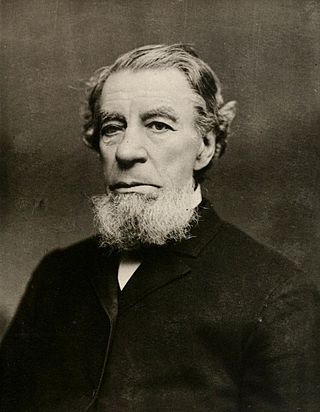
Gurdon Saltonstall Hubbard was an American fur trader, insurance underwriter, and land speculator. He was influential in the development of the city of Chicago and responsible for its growth during the 19th century. First arriving in Chicago in 1818, he settled in the area in the late 1820s. He became one of the most prominent residents of the town and was one of its first trustees in 1833. He went on to build Chicago's first stockyard and help foment a land boom for Chicago in the East.

The Old Treaty Elm marked the Northern boundary of the Fort Dearborn Reservation, the approximate edge of the Billy Caldwell Reserve, and the trail to Lake Geneva. The tree was located in the Sauganash neighborhood of Chicago, Illinois, and stood until 1934. The marker is placed several feet west of the actual location of the trunk of the tree, which stood approximately in the middle of what is now Kilbourn Avenue, just north of Rogers Avenue, which is the Old Indian Boundary Line.
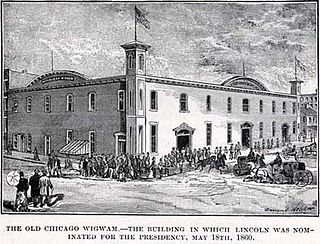
The Wigwam was a convention center and meeting hall that served as the site of the 1860 Republican National Convention. It was located in Chicago, Illinois, at Lake Street and Market near the Chicago River. This site had previously been the site of the Sauganash Hotel, Chicago's first hotel. This is where supporters ushered Abraham Lincoln to the party nomination and the eventual U.S. Presidency. The location at Lake and Wacker was designated a Chicago Landmark on November 6, 2002. The name "Wigwam" was later associated with host locations for both the 1864 Democratic National Convention and the 1892 Democratic National Convention in Chicago.

Julius White was an American businessman and brigadier general in the Union Army during the American Civil War. After the war, he served as U.S. Minister (ambassador) to Argentina.

The Chicago Opera House was a theater complex in Chicago, Illinois, designed by the architectural firm of Cobb and Frost. The Chicago Opera House building took the cue provided by the Metropolitan Opera of New York as a mixed-used building: it housed both a theater and unrelated offices, used to subsidize the cost of the theater building. The theater itself was located in the middle of the complex and office structures flanked each side. The entire complex was known as the "Chicago Opera House Block," and was located at the Southwest corner of West Washington Avenue and North Clark Street.
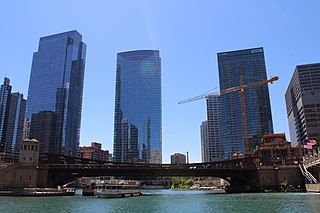
Wolf Point is the location at the confluence of the North, South and Main Branches of the Chicago River in the present day Near North Side, Loop, and Near West Side community areas of Chicago. This fork in the river is historically important in the development of early Chicago. Located about 1.6 miles (2.6 km) from Lake Michigan, this was the location of Chicago's first three taverns, its first hotel, Sauganash Hotel, its first ferry, its first drug store, its first church, its first theater company, and the first bridges across the Chicago River. The name is said to possibly derive from a Native American Chief whose name translated to wolf, but alternate theories exist.
Antoine Ouilmette was a fur trader and early resident of what is now Chicago, Illinois. He was of French Canadian and possibly Native American ancestry. The village of Wilmette, Illinois is named in his honor.

The La Salle Hotel was a historic hotel located on the northwest corner of La Salle Street and Madison Street in the Chicago Loop community area of Chicago, Illinois, United States. It was designed by Holabird & Roche and opened in 1909. After a major fire in 1946, the hotel was refurbished and reopened in 1947. It closed in 1976 and was demolished for construction of an office building.

Jean Baptiste Beaubien, a multi-lingual fur-trader born in Detroit, Michigan, became an early resident of what became Chicago, Illinois, as well as an early civic and militia leader in Cook County, Illinois during the Black Hawk War, before moving to Du Page County, Illinois in his final years.

Alexander Robinson, was a British-Ottawa chief born on Mackinac Island who became a fur trader and ultimately settled near what later became Chicago. Multilingual in Odawa, Potawatomi, Ojibwa, English and French, Robinson also helped evacuate survivors of the Fort Dearborn Massacre in 1812. In 1816, Robinson was a translator for native peoples during the Treaty of St. Louis. He became a Potawatomi chief in 1829 and in that year and in 1833, he and fellow Metis Billy Caldwell negotiated treaties on behalf of the United Nations of Ottawa, Chippewa, and Potawatomi with the United States. Although Robinson helped lead Native Americans across the Mississippi River in 1835, unlike Caldwell, Robinson returned to the Chicago area by 1840 and lived as a respected citizen in western Cook County until his death decades later.

The 1837 Chicago mayoral election was held on May 2, 1837. It was the first Chicago mayoral election, taking place the same year as Chicago's incorporation as a city. Democratic candidate William B. Ogden defeated Whig incumbent Town President John H. Kinzie by a landslide 38.5 point margin.
Henry L. Newhouse (1874–1929) was an architect in Chicago, Illinois. His work includes the Milford Theatre (Chicago), Blackstone-State Theater, and Sutherland Hotel. He also designed Elam House (1903) and Chicago Defender Building.
Thomas Jefferson Vance Owen was an American settler who was the first president of the Board of Trustees of the Town of Chicago.
